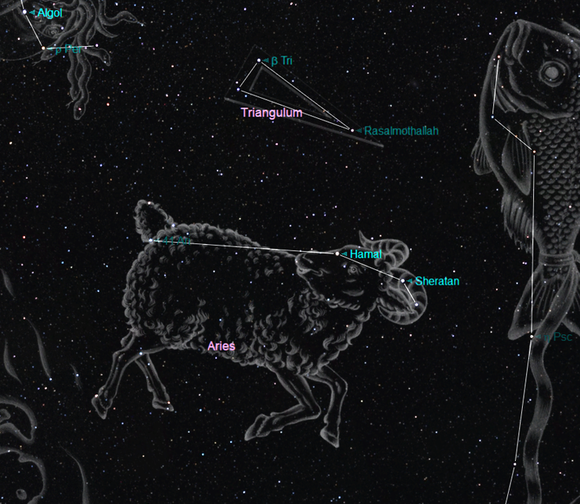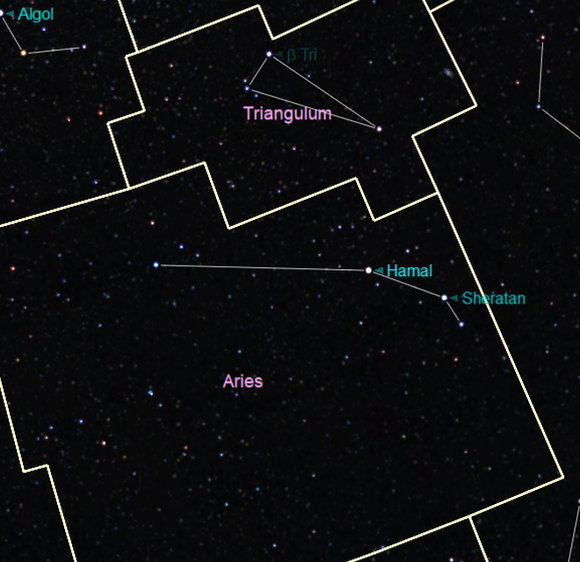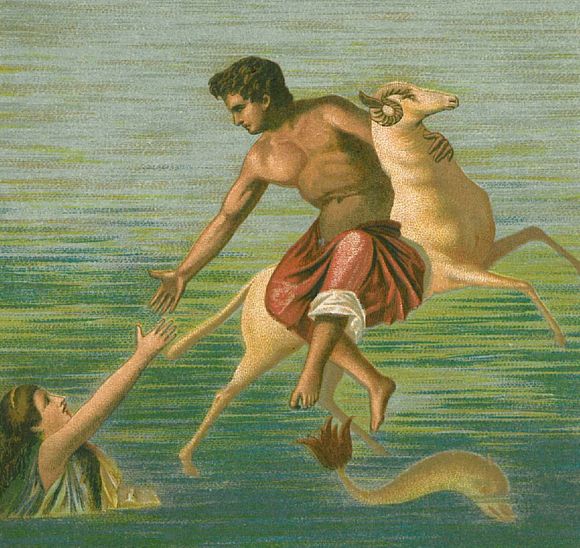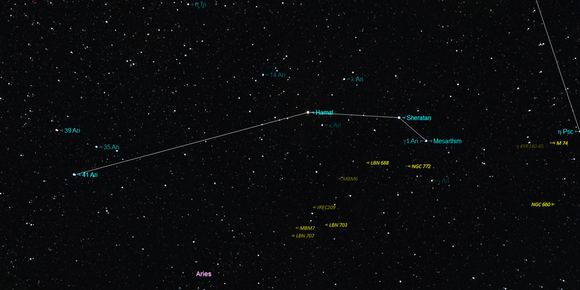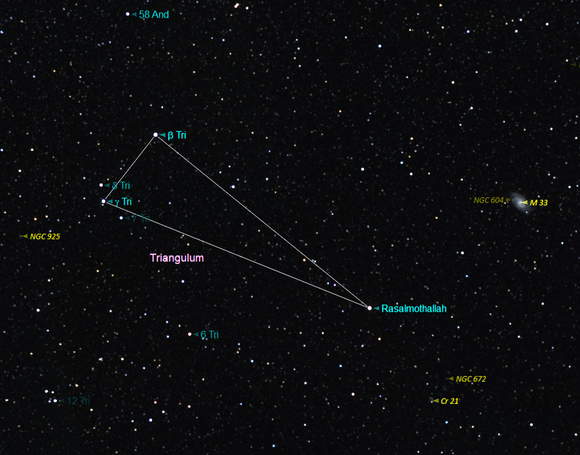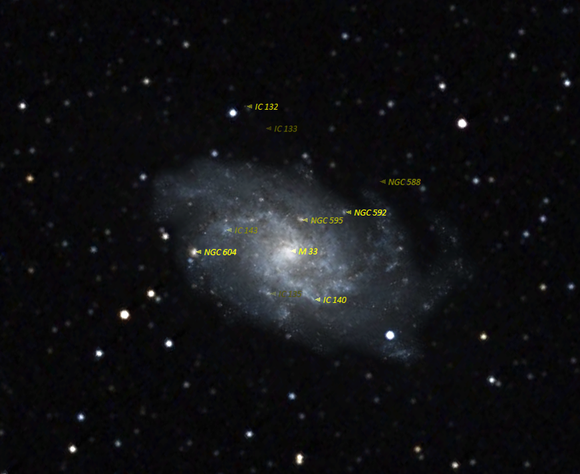Aries - The Ram
Aries (Latin for ram) is one of the constellations of the zodiac. It is bounded by Triangulum to the north, Pisces to the west, Perseus and Taurus to the east and Cetus to the south. It is one of the original 48 constellations described by the 2nd century astronomer Ptolemy, ranking 39th in overall size, with an area of 441 square degrees, although the main stellar asterism is quite small. The location of the vernal equinox, when the Sun crosses the celestial equator from South to North, is named for the constellation; the First Point of Aries. This was the case more than two millennia ago, but because of the precession of the equinoxes (Earth's slow wobble upon its axis) the First Point of Aries has since moved into Pisces and will move into Aquarius by around 2600 AD. In ancient Egyptian astronomy, Aries was associated with the god Amon-Ra, who was depicted as a man with a ram's head and represented fertility and creativity. The earliest identifiable reference to Aries as a distinct constellation date from 1350 to 1000 BC.
In Greek mythology the constellation of Aries is associated with the ram that rescued Phrixus and his sister Helle. They were the son and daughter of King Athamas and his first wife Nephele. The king's second wife, Ino, was jealous and wished to kill his children. To accomplish this, she induced a famine in Boeotia, then falsified a message from the Oracle of Delphi that said Phrixus must be sacrificed to end the famine. A ram sent by Nephele arrived in time to save her children, but in flight Helle fell from Aries's back and perished in the Dardanelles, known today as the Hellespont in her honor. On reaching the land of Cholchis, the Ram's fleece turned to gold, which Phrixus presented to King Aeëtes, who in return gave the hand of his daughter, Chalciope, in marriage. The fleece was placed in a sacred temple grove, guarded by a creature, (some say multi -headed dragon) and eventually pinched by Jason and the Argonauts, but that's another story.
Ancient roman fresco found in Pompeii, now in the Archaeological Museum in Naples
Phrixus, Helle and the Ram (click for full image)
Aries has 6 named stars, 3 of which form a small 'crooked line' asterism. The stars are:-
- Alpha Arietis - Hamal is the brightest star in the constellation and just makes it into the top 50 brightest star in the night sky. It is a K-type orange giant roughly twice as massive as the Sun. It is slightly variable with an apparent magnitude range of 1.98 to 2.04. The star is 66 light years distant. Between 2000 and 100 BC, Hamal was located at the vernal equinox, the point that marks the beginning of spring. The name Hamal means lamb and derives from the Arabic phrase rās al-ħamal, meaning “head of the ram.”
- Beta Arietis - Sheratan is a white main sequence star and a spectroscopic binary, 59.6 light years distant. The companion is suspected to be a G class star. Sheratan has a visual magnitude of 2.64. The name comes from the Arabic phrase aš-šarāţān, which means “the two signs,” and refers to the vernal equinox, which the star marked together with Gamma Arietis a few thousand years ago.
- Gamma Arietis - Mesarthtim is a triple star system which includes a binary star system composed of two white A-type main sequence stars with apparent magnitudes of 4.75 and 4.83, lying 7.7 arc seconds apart, and a third component, a magnitude 9.6 K-type star that lies 221 arc seconds away. The two A class stars are seen well in small instruments, resembing a pair of car headlights approaching from a distance! The system is approximately 160 light years distant.
- Delta Arietis - Botein is an orange K-type giant star approximately 168 light years from Earth. It has an apparent magnitude of 4.35. The name is derived from the Arabic word butain, which means “belly.”
- 41 Arietis, (c Arietis) or Bharani, belongs to the spectral class B8Vn and is 160 light years distant. Its apparent magnitude is 3.61. The star was named after the second lunar mansion (division of the sky) in Hindu astrology.
- 39 Arietis - Lilii Borea is a star of magnitude 4.51, 172 light-years away. Its spectral class is K1 and its absolute magnitude is 0.0.
- Epsilon Arietis is a binary star, approximately 293 light years distant. It is composed of two white A-type main sequence dwarfs separated by 1.5 arc seconds. The components have apparent magnitudes of 5.2 and 5.5. The combined magnitude of the double star is 4.63.
Deep Sky Objects
Aries contains no Messier objects, but is not devoid of interest to the amateur astronomer.
- NGC 772 is a spiral galaxy with a magnitude of +10.3, located southeast of Sheratan and 15 arcminutes west of 15 Arietis. It is reasonably bright and shows obvious nebulosity and shape in an amateur telescope. NGC 772 is a class SA(s)b galaxy; unbarred spiral galaxy, possessing a prominent bulge and quite tightly wound spiral arms. The main arm, on the northwest side of the galaxy, is home to many star forming regions from previous gravitational interactions with other galaxies. It has a diameter of 240,000 light-years. NGC 772 has a small companion galaxy, NGC 770, that is about 113,000 light-years away from the larger galaxy. The two galaxies together lie 114 million light-years from Earth.
-
NGC 673, a face-on class SAB(s)c galaxy. It is a weakly barred spiral galaxy with loosely wound arms. It has no ring and a faint bulge and is 2.5 by 1.9 arcminutes. It has two primary fragmented arms. NGC 673 is 171,000 light-years in diameter and lies 235 million light-years from Earth.
-
NGC 678 and NGC 680 are a pair of galaxies 200,000 light-years apart at a distance of approximately 130 million light-years. NGC 678 is an edge-on spiral galaxy 171,000 light-years in diameter that is 4.5 by 0.8 arcminutes in size with a magnitude of 13.35. NGC 680 is an elliptical galaxy with a diameter of 72,000 light-years and is the brighter of the two at magnitude 12.9. Both galaxies have bright cores.
-
NGC 691 is a spiral galaxy slightly inclined to our line of sight. It has multiple spiral arms and a bright core. Because it is so diffuse, it has a low surface brightness. It has a diameter of 126,000 light-years and is 124 million light-years away.
-
NGC 877 is the brightest member of an 8-galaxy group that also includes NGC 870, NGC 871, and NGC 876. NGC 877 is 178 million light-years away with a diameter of 124,000 light-years, this equates to a magnitude of 12.53 and 2.4 by 1.8 arcminutes in size. Its companion is NGC 876, which is about 103,000 light-years from the core of NGC 877. They are interacting gravitationally, as they are connected by a faint stream of gas and dust.
-
NGC 821 is an E6 elliptical galaxy. It is unusual because it has hints of an early spiral structure, which is normally only found in lenticular and spiral galaxies. NGC 821 is 2.6 by 2.0 arcminutes and has a visual magnitude of 11.3. Its diameter is 61,000 light-years and it is 80 million light-years away
Triangulum
Triangulum is one of the original Ptolemaic constellations listed in the 2nd century AD. Ranked 78th of the 88 constellations, in size Triangulum covers 132 square degrees. It is bordered by Andromeda to the north and west, Pisces to the west and south, Aries to the south, and Perseus to the east. There are no real mythology tales associated with the group, however the Greeks knew the constellation as Deltoton, named for its shape, which resembled the capital Greek letter delta. Eratosthenes said that the constellation represented the delta of the river Nile.
Of the three stars that make up the long narrow triangle that gives the constellation its name:
- Beta Trianguli, with an apparent magnitude 3.0 is the brightest member. It is a spectroscopic binary system with the primary a star of spectral type A5IV (white) and a secondary which may be a yellow-white F-type main-sequence star. The primary star has a mass 3.5 times that of our sun that is beginning evolve off the main sequence. The secondary is poorly known, but calculated to be a around 1.4 solar masses. The two orbit around a common centre of gravity every 31 days, and are surrounded by a ring of dust that extends from 50 to 400 AU away from the stars. The system lies 127 light-years from Earth.
- Alpha Trianguli - Caput Trianguli or Ras al Muthallath is the second-brightest star and marks the apex of the triangle. It is a yellow-white subgiant star of magnitude +3.4 with a close dimmer companion.
- Completing the triangle is Gamma Trianguli, a white main sequence star of spectral type A1V and an apparent magnitude +4.0. Twice the size and over 33 times more luminous than the Sun, it rotates very quickly and is surrounded by a dusty debris disk. Located near Gamma, forming an optical triple system with it are Delta and 7 Trianguli. The latter star is around 280 light-years distant from Earth, whereas Delta is just 35 light years away. Gamma itself lies 112 light-years from Earth.
- Iota Trianguli is a double star whose components can be separated by medium-sized telescopes into yellow and a contrasting pale blue star. Both stars are themselves close binaries.
- R Trianguli is a long period (Mira) variable that ranges from magnitude 6.2 to 11.7 over a period of 267 days. It is a red giant of spectral type M3 and lies 960 light-years away.
Deep Sky
Although small, Triangulum contains one famous Messier object- M33, NGC 598 the Pinwheel galaxy, discovered by Giovanni Battista Hodierna in the 17th century and rediscovered by Messier in 1764. At a distance of about 2.7 million light-year, M33 is the third largest member of the Local Group and at magnitude 5.8 may be seen by the naked eye under very dark, transparent skies. Being a diffuse object seen face on, it is challenging to spot under light-polluted skies or when strong moonlight is present. Binoculars or a small telescope at low power will do the job, but it is tricky in long focal length instruments.
M33 is a spiral galaxy with a diameter of 46,000 light-years, considerably smaller than both the Miky Way and the Andromeda Galaxy. M33 lies closest to M31 being just 130,000 light years or so from it and may even be a satellite of the larger galaxy. M33 lies near the border of Pisces, 3.5 degrees west-northwest of Alpha Trianguli and 7 degrees southwest of Beta Andromedae. In addition to M33, there are several NGC galaxies located in Triangulum, the brightest and lagest of which are NGC 925, a spiral galaxy 10 arcminute long and magnitude 12, and NGC 672 a 5 arcminute long magnitude 11.6 barred spiral galaxy which appears to be interacting with IC 1727. The two are 88,000 light-years apart and lie around 18 million light-years away.
Do pay a visit to these two constellations.
- Sky Charts: Stellarium Software and Starry Night Pro Plus 8
- Log in to post comments

